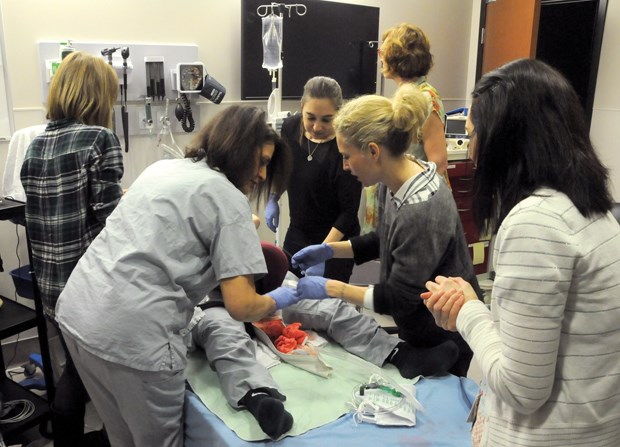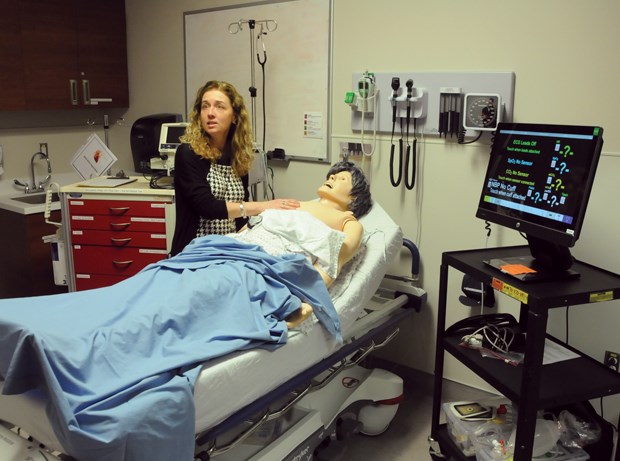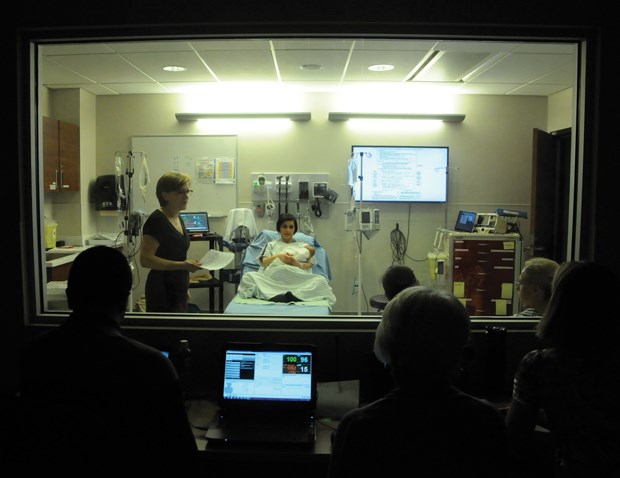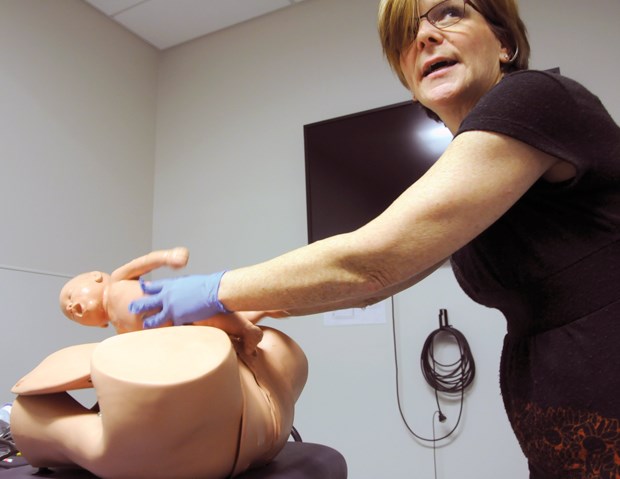“Dr. Lawson is stuck in traffic,” a voice on the intercom cuts through a chaotic birthing suite.
This is bad news.
Two hours ago, the patient gave birth to a healthy baby girl, seven pounds, 15 ounces.
The baby is resting well but a check-in from the primary nurse has found mom is hemorrhaging.
It occurs in up to 18 percent of births and it’s the most common cause of death in developed countries for mothers in childbirth.
But it’s manageable if they get a move on, with or without Dr. Lawson.

The instructions are to administer oxytocin, hemabate and ergot to induce contractions and control the bleeding, massage the patient’s uterus to remove any remaining blood clots and call the lab to get a blood bag ASAP.
“Just do these three things and it will keep her from falling off the edge,” the voice on the intercom says.
There’s a cacophony of acronyms being shouted out and monitors beeping as nurses go to work connecting IV bags and crowding around the patient.
When it’s done and the beeping of the various monitors subsides, everyone settles down.
“I’m OK,” the patient says. “Can you stop rubbing my belly?”
It was a tense moment, and hopefully, a learning experience. It is, after all, just a simulation.
***
For the last year, Lions Gate Hospital staff have been sharpening their skills and learning new techniques in the SIM program, which involves everything from hyper-realistic dummies to paid actors.
The postpartum hemorrhaging simulation and some even more sophisticated exercises are having a real world positive outcomes in what can be life-or-death medical emergencies.
“The research is rich,” says Karen Schafer, education lead in the SIM program.
When it comes to medical professionals learning by reading a book or listening to a lecture, “it doesn’t compare nearly to what a simulator can achieve,” she said.
Dr. Lawson, by the way, is stuck in traffic pretty much every time they run this particular simulation. The patient, who happens to be played by a Lions Gate nurse. is wearing a strap-on uterus.
Things get considerably more high tech than that, however, especially with SimMan, a mannequin with some decidedly human features.

“They load his leg with saline or distilled water and that can be pumped up to his brow and we can make him sweat,” Schafer says, while giving a demonstration.
Midway through the explanation, SimMan starts wheezing, terribly. Richard Pinto, the SIM operations specialist, is controlling SimMan’s symptoms from behind a Wizard of Oz-like curtain.
“These are ways of giving the learner the information they need from a mannequin and not from us standing over here saying ‘blah blah blah.’ They can stay focused on what they would normally stay focused on,” Schafer said.
He can cry. His nose runs. He’s also got a working bladder and urethra, which students can practice putting catheters in, presumably a task that was hard to get volunteers for in the past.
SimMan’s pupils dilate and constrict when there’s a light flashed in his eyes. He has a fluctuating pulse and blood pressure. His heart may have a murmur or an arrhythmia and caregivers can get a window into his health just by listening to his lungs.
Frothing at the mouth could mean he’s ingested poison or having a seizure.
At that point, SimMan begins trembling. Pinto is making him seize.
In the event of a brain injury, a patient’s jaw might clench tight, which SimMan can also do. If his lips are turning blue, it’s possibly because he’s not getting enough oxygen. If there’s no way to intubate him, SimMan is even prepped to have someone practise a tracheostomy on his throat.
He responds to standard vital signs monitoring equipment and a real-life defibrillator.
“We can make him have all kinds of rhythms and different kinds of rates that will give the learner the information they need to know whether he needs to be shocked or not. And he can really be shocked,” Schafer says. “We snap on the pads; we really put electricity into him.”
SimMan cries out in pain from the zap.
“It hurts, I know,” Schafer sympathetically responds to him, in her best nurses’ voice.
***
SimMan is a top-of-the-line model, selling for about $100,000 from a Norwegian company. Lions Gate has him as well as a SimJunior and SimBaby, though they don’t have all the bells and whistles the adult model has.
The dummies, if you can call them that, as well as the entire SIM suite were paid for with a $1.5 million donation from the Lions Gate Hospital Foundation, including $500,000 from the family of Kevin and Patricia Huscroft. UBC’s faculty of medicine, which uses the HOpe Centre for training, also contributes to the SIM program.
Everyone a patient might encounter in an emergency is included in the SIMs including surgeons, nurses, social workers and even spiritual support. The scenarios range from heart attacks to car accidents.

Though working hands-on with no fear of making mistakes has its advantages, the real benefit comes from the debrief afterward. Everyone who participated in the SIM sits together in a guided conversation looking for the “Aha moments” as to how it could have gone better.
When the trainees in the postpartum SIM were removing the blood clots, they placed them on a nearby scale to determine how much blood the patient had lost. Unfortunately, that’s also where the infant was left. North Shore News photographer Mike Wakefield stepped in and held the baby for the rest of the exercise. It’s probably something that would come up in the debrief.
***
Not long after they began the program, medical teams at the hospital used the SIMs to run through an asthma attack scenario where they were tasked with using a new device to administer Ventolin.
“It was a new experience for them. The SIM was new and using this mechanism was new,” Schafer said. “Two weeks later, the exact same case came in. Right away, they said ‘Let’s use that new tool.’ They felt so confident in being able to treat that patient, whereas before, they would have been struggling.”
There’s also the worst-case scenario when a patient “codes,” meaning they are deteriorating rapidly and will likely die without fast intervention.
“It’s an infrequent thing that scares the heck out of them and they don’t know what to do in those first five minutes before the big team comes to save the day and they have huge responsibilities,” she said.
Again, two weeks later, the real life scenario played out for an LGH nurse.
“She said, ‘Thank god I did the SIM. I would not have known what to do if I hadn’t done it.’ She felt like the patient survived because she knows what to do,” Schafer said. “I get those stories often.”



